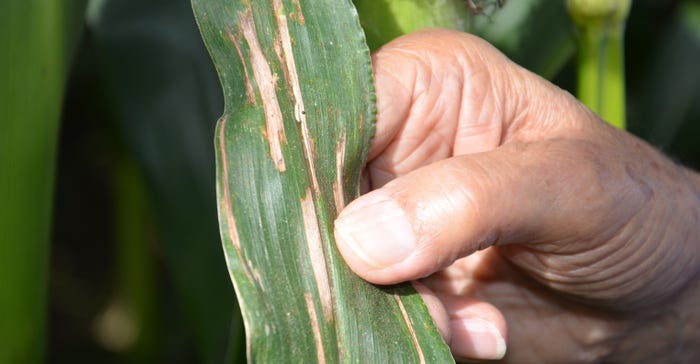
Judging corn exhibits at county fairs around Indiana throughout June and July was enlightening and encouraging for two reasons. First, less gray leaf spot showed up on exhibits than expected. Parents and kids select their best plants, but if the entire field has lesions, they have no choice. Second, where gray leaf spot lesions were only a leaf below the ear leaf, even the 4-H’er knew that the field was going to be sprayed with fungicide. In one instance, Dad confirmed that the helicopter was headed for the field soon.
The Corn Watch ’21 field was also clean in June and even early July. However, Dave Nanda, director of genetics for Seed Genetics Direct, sponsor of Corn Watch ’21, says this would be the wrong year to stop scouting corn now. Conditions as weather unfolded in later July over much of the state continued to be humid, warm and wet. Nanda says those are ideal conditions for gray leaf spot.
Related: Heavy rains may lead to pocket nitrogen issues
“The disease can develop in a hurry and go from a lesion here and there to a real threat very quickly,” Nanda says. “The inoculum is there. All you need are the right conditions and a susceptible host. Corn hybrids without good resistance to gray leaf spot would be the host.”
Gray leaf spot isn’t the only disease to worry about, he notes. Tar spot was documented in Indiana by early July. This newer corn disease, especially prevalent when conditions are right in northern areas, can also be a threat to yield.
Gray leaf spot infection
One year ago in the Corn Watch field, when Nanda checked corn at the 12-leaf stage, there were few, if any, gray leaf spot lesions. Where the field was located, the 2020 season featured enough moisture but was not as wet as 2021 through July.
“When I came back after corn was tasseling and silking, gray leaf spot was running rampant, especially on lower leaves,” Nanda recalls. “It fact, it was so intense on some leaves that we sent samples to Purdue University to confirm that it was gray leaf spot and not a newer disease, bacterial leaf streak, which has appeared in Illinois but has not yet been confirmed in Indiana.
“As I suspected, it was gray leaf spot when the results came back. It was just growing as a very intense infection on lower leaves, and some lesions were moving up to higher leaves on the plant.”
The goal is to protect the ear leaf and leaves above it, Nanda notes. Those are the critical leaves that require protecting to make sure the plant can conduct enough photosynthesis to produce adequate sugars to fill kernels during grain fill.

Nanda didn’t wait for the results to come back from Purdue to contact the grower. He let the grower know what he’d seen. The grower normally uses field equipment to spray fungicide where needed. However, since it had rained and was too wet for ground application, he hired the field sprayed by helicopter. The application stopped the fungus from developing further, and protected yield potential.
“The field wound up yielding well,” Nanda says. “The lesson we learned, which applies this year, is that leaf diseases can move in fast if conditions are right. If not checked by fungicides, they can definitely cause yield losses on susceptible hybrids.”
About the Author(s)
You May Also Like




